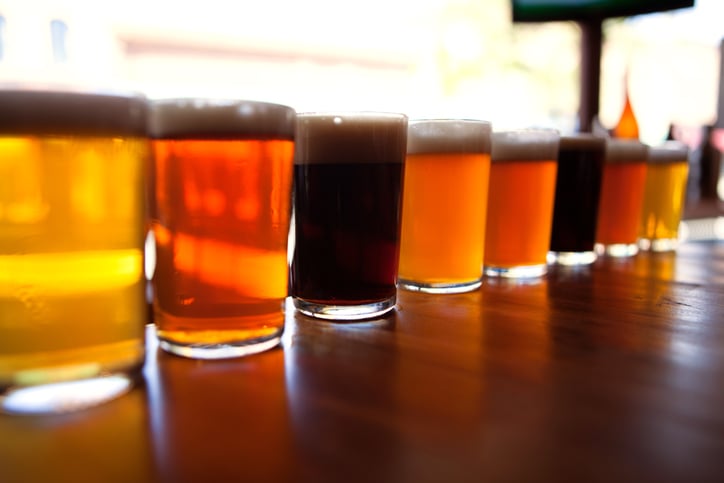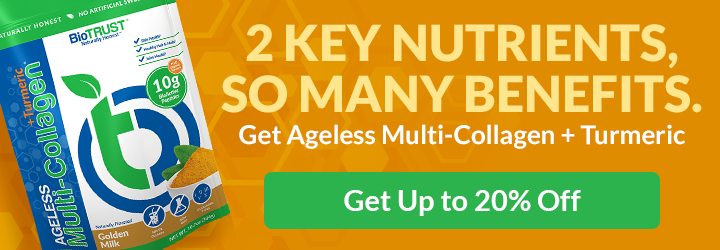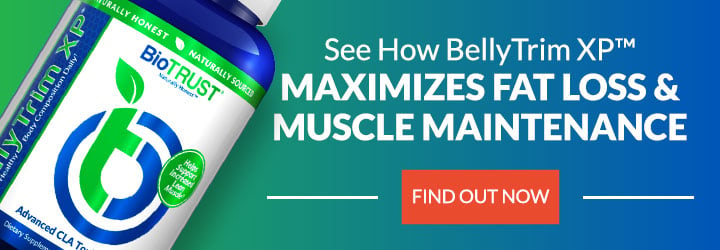The Healthiest Beers to Drink: A Complete List [Updated 2023]

Before we go any further, let’s be completely clear: We neither condone nor condemn alcohol consumption—as long as it’s light to moderate and you’re of age. Of course, it goes without saying that excess consumption is bad news, and not just for your waistline. It’s well known that alcohol lowers inhibitions, which can lead to poor food choices, overeating, poor sleep quality, skipping workouts, and more.
Excess drinking can also lead to the oh-so-unpleasant “brown-bottle flu,” i.e., hangover symptoms, including dehydration, painful headaches, nausea, vomiting, and just feeling awful. Even worse, there are obvious long-term repercussions of heavy drinking, including brain atrophy, liver damage, premature aging, and even early death. In fact, excess alcohol consumption can lead to increased risks for virtually all disease.
That said, there’s also evidence that when consumed in moderation, especially when enjoyed with friends as part of an overall healthy lifestyle, alcohol may improve various aspects of health. Some research even indicates moderate consumption could help protect against weight gain. One small study also found moderate alcohol consumption was associated with a lower chance of getting a common cold (though only in folks who also don’t smoke).
While abstaining from alcohol may be the best option for many people, multiple studies have shown light to moderate alcohol consumption can have potential benefits, such as:
- Reducing stress as found in both physiologic and self-report measures.
- Increasing overall affective expression, happiness, and pleasant and carefree feelings. Tension, depression, and self-consciousness have also been reported to decrease with lower amounts. Remember, this is only with light to moderate drinking. Heavy drinking has the opposite effect. In fact, heavy drinkers as well as abstainers have higher rates of clinical depression than do regular moderate drinkers.
- Low alcohol amounts have been found to improve certain types of cognitive performance such as problem-solving and short-term memory.
Beer Fun Fact: By volume, beer is the most consumed alcoholic beverage globally.
Beer vs. Wine
Now, when most people think of healthy drinks, red wine is the first one to come to mind. Conversely, most wouldn’t equate beer with a healthy diet. Rather, the first thing that often comes to mind is the dreaded “beer belly.”
But that may not be the case. In fact, when small amounts are consumed as part of an overall healthy lifestyle, the risk of the unfortunate beer belly don’t seem to be there.
In other words, if you are able to keep your drinking moderate and avoid drinking daily, when it comes to beer, bottoms up!
The Healthiest Beers to Drink
Light Beers
Light beers are the lowest in calories, alcohol, and carbohydrates, so they’re often considered the best options. Sadly, though, many people find the lower alcohol content also tends to equate to lower levels of flavor. This also makes it easier to consume more beers, which again negates any potential benefits. So, if you opt for a light beer, be mindful of your consumption, and stop after just one or two.
That said, there are a lot of light beers available, and while tastes and preferences differ for all of us, there are many on the list that are pretty darn tasty. Some taste a bit more exotic, and others provide less flavor and are thus can be good for easy drinking on a hot day.
Here are some of our healthiest beer recommendations in the light beer category, all of which come in under 100 calories:
- Budweiser Select 55 (55 calories, 1.9g carbs)
- Miller 64 (64 calories, 2g carbs)
- Beck’s Premier Light (64 calories, 3.9g carbs)
- Bud Light NEXT (80 calories, 0g carbs)
- Michelob Ultra Pure Gold Organic (85 calories, 2.5 g carbs)
- Yuengling Flight (85 calories, 2.6g carbs)
- New Holland Brewing Co Light Point (86 calories, 2.3g carbs)
- Island Active Premium Light Beer (88 calories, 2.6g carbs)
- Corona Premier (90 calories, 2.6g)
- Heineken Light (90 calories, 6g carbs)
- Kurin Light (95 calories, 0g carbs)
- Michelob Ultra (95 calories, 2.6g carbs)
- Amstel Light (95 calories, 5g carbs)
- Miller Light (96 calories, 3.2g carbs)
- Budweiser Select (96 calories, 3.1g carbs)
- Kona Brewing Co Light Blonde Ale (99 calories, 4g carbs)
- Yuengling Light Beer or Lager (99 calories, 8.5g carbs)
- Corona Light (99 calories, 5g carbs)
Beer Fun Fact: Moderate beer drinking may be beneficial for preventing cardiovascular (e.g., heart disease and ischemic stroke) and neurodegenerative conditions as it helps blood flow. That being said, eating a healthy diet and being physically active have much greater health benefits and have been more extensively studied.
Regular and Dark Beers
If you’re not one for drinking carbonated water that’s slightly yellow in color with a hint of flavor and alcohol (you know, light beers), you still have a lot of options. Perhaps you prefer a little more body. If so, there are some “regular,” fuller-flavor, darker beers that made the cut as well.
Wait! Dark beers? Aren’t they loaded with calories and carbs? Not so fast.
In fact, some of the healthiest beers have robust flavor and color. For instance, the tasty, full-bodied stout Guinness Draught has a mere 126 calories with just under 10 grams of carbs.
Another flavorful option, Yuengling Traditional Lager (an amber lager) provides 135 calories and boasts a higher alcohol content than its lower-calorie light counterpart.
If you want a darker, robust brown ale that clocks in with less than 100 calories, Anderson Valley Black Rice Ale provides a rich flavor as its brewed with roasted malt, coffee, and chocolate. It’s a bit thinner and lighter but has a similar flavor to a Guinness type stout with just 97 calories and 8 grams of carbs.
Bustling with flavor and packaged in a unique, stubby bottle with a cool logo, Full Sail Session Lager contains just 135 calories and 10 grams of carbs.
If you’re looking for something with a slightly different flavor palette on a warm, sunny day, try Pacifico, which is a Mexican pilsner that rings in at just 135 calories and 12 grams of carbs.
Other lower-calorie yet fuller-flavored beers of all varieties to consider include:
- Bluemoon LightSky Citrus Wheat (95 calories, 3.6g carbs, 4% ABV)
- Sufferfest Repeat Kolsch Style Beer (95 calories, 5g carbs, 3.5% ABV)
- Bell’s Light Hearted Ale (110, 8.7g carbs, 3.7% ABV)
- Stone Buenaveza Salt & Lime Lager (140, 11g carbs, 4.7% ABV)
- Odell Brewing Cutthroat (145 calories, 12g carbs, 5% ABV)
- Bass Pale Ale (150 calories, 12g carbs, 4.7% ABV)
- Young’s Double Chocolate Stout (150 calories, 21g carbs, 5.2% ABV)
- Grolsch Premium Pilsner (165 calories, 2.5g carbs, 5% ABV)
- Negra Modelo Dark Beer (172 calories, 16g carbs, 5.4% ABV)
- Murphy’s Irish Stout (190 calories, 3.6g carbs, 4% ABV)
You will, however, want to watch your consumption. Darker and more hoppy beers tend to be higher in calories—between 150 and 200 per pint—and carbs. They’re also more likely to lead to hangover symptoms when overserved. This is because darker beers and drinks contain more congeners, which can cause a stronger, longer-lasting hangover.
Again, moderation is key. Studies have found excess alcohol consumption can negatively affect the body’s ability to fight off infections and may contribute to a weakened immune system. So, stick within the “acceptable” consumption limits, whether you’re drinking lighter or darker beers.
Beer Fun Fact: By no means is beer a nutrient powerhouse. However, it does provide amino acids, minerals (including calcium, iron, magnesium, phosphorus, potassium, sodium, zinc, copper, manganese, selenium, fluoride, and silicon), and vitamins (including B vitamins).
Supercharge Your Diet Results with IC-5
IC-5, which is scientifically-designed to promote insulin sensitivity and improved carb tolerance, is one of our top diet-boosting supplement.
With IC-5, you know that you are supporting carbohydrate tolerance, keeping potentially harmful AGEs at bay, and amplifying the anti-aging effects of the ketogenic diet. It’s a triple threat for overall health and anti-aging!
Hoppy Beers
If you’re a bit more of a beer snob (like many of us), we have good news for you. You can still enjoy great-tasting craft beer without packing on the pounds. Even more, hop-heavy, flavorful beers may even possess some unique health benefits.
Like red wine, beer contains health-promoting polyphenols. For instance, xanthohumol, the most abundant flavonoid in hops, has been shown to possess powerful antioxidant and anti-inflammatory activity. What’s more, xanthohumol has been shown to stimulate the growth of beneficial gut bacteria and inhibit pathogen bacteria, exerting prebiotic-like effects.
In addition, hops also contain a compound called isohumulones, which give beer its bitter taste. Research has shown that isohumulones possess a variety of health benefits, including improving carbohydrate management, cholesterol metabolism, and blood pressure.
In a randomized, controlled study published in the journal Clinical Nutrition, Japanese researchers found that fasting blood sugar and body weight significantly decreased in human volunteers after 12 weeks of supplementation with isohumulones.
Not surprisingly, “hoppy” beers have the highest concentrations of these unique hop-derived compounds. For instance, craft beers have about 7 to 20 times more xanthohumol and 3 to 7 times more isohumulones than light beers. With that being said, “hoppy” craft beers are also typically substantially higher in calories and alcohol. In other words, there’s a fine line between healthiest beers benefits and detriments.
Along those lines, “session” beers are a good option, as these are lower in calories and alcohol.
Here’s a list of a few of the healthiest beers of the hoppy variety:
- Summit Triumphant Session IPA (95 calories, 4% ABV)
- Dogfish Head Slightly Mighty IPA (95 calories, 4% ABV)
- Firestone FlyJack Hazy IPA (96 calories, 5g carbs, 4% ABV)
- Lagunitas Daytime IPA (98 calories, 3g carbs, 4% ABV)
- Goose Island So-Lo IPA (98 calories, 9g carbs, 3% ABV)
- Da Shootz! American Pilsner (99 calories, 4% ABV)
- Oskar Blues One-Y IPA (100 calories, 5g carbs, 4% ABV)
- Wallenpaupack Brewing Company Smallmouth IPA (105, 3g carbs, 4.4%)
- ODell Good Behavior Crushable IPA (110 calories, 7g carbs, 4% ABV)
- Stone Brewing Co. Levitation Ale (132 calories, 4.4% ABV)
- Flying Dog Session IPA (141, 4.7% ABV)
- Stone Brewing Co. Go to IPA (144 calories, 4.8% ABV)
- Founders All Day IPA (147 calories, 4.7% ABV)
- Sierra Nevada Pale Ale (175 calories, 5.6% ABV)
- Deschutes Chainbreaker White IPA (180 calories, 5.6% ABV)
- New Belgium’s Voodoo Ranger (187, 14g, 7% ABV)
- Lagunitas IPA (190 calories, 14g carbs, 6.2% ABV)
Beer Fun Fact: Beer, along with wine, is an integral part of the Mediterranean diet.
Dry Hard Cider
It’s not beer, but it comes in a can, it’s carbonated, it has alcohol, and you drink it cold. It seems like it’s worthy of the list.
While beer has long held the position as the preferred alcoholic beverage, there’s been a surge in the market for hard apple cider in recent years. Compared to light beers, hard cider typically contains more calories and carbohydrates. Unlike beer, which is sugar-free (unless the brewer adds sugar), hard cider contains sugar—sometimes, a lot of it.
Hard cider is made with apples or other fruits, which possess a range of health benefits. Plus, hard cider is darn refreshing. When choosing a hard cider, we recommend opting for dry cider, which is typically lower in sugar and calories. Here are a few of our favorite healthiest ciders:
- Woodchuck Crisp Hard Cider (120 calories)
- Michelob Ultra Light Cider (120 calories)
- Magners Irish Cider (125 calories)
- Crispin Natural Hard Apple Cider (140 calories)
- Harpoon Cider (140 calories)
- Strongbow Cider (140 calories)
- Wyder’s Apple Cider (150 calories)
- Samuel Smith Organic Cider (150 calories)
Now that you know the truth about the healthiest beers, crack open and enjoy a cold one (in moderation, of course).
BREAKING: Forget Taking Collagen, Try This 21-Second Trick for Healthier Skin & Hair Instead
Gluten-Free Beers
Beer is typically made from wheat and barley, which both contain the protein gluten. Unfortunately, a lot of folks find that gluten doesn’t exactly agree with their systems. It can lead to bloating, discomfort, and worse—including severe allergic reactions, especially for people who have celiac disease. Fortunately, brewers are starting to take note and make gluten-free options. A few good ones to consider are:
- Aurochs Light Lager (85 calories, 3.4% ABV)
- Omission Ultimate Light Golden Ale (99 calories, 3g carbs, 4.2% ABV)
- St. Peter’s Sorgham Beer (126 calories, 4.2% ABV)
- Joseph James FoxTail Pale Ale (130 calories, 5% ABV)
- Glutenberg Session IPA (151 calories, 4.5% ABV)
Non-Alcoholic Beers
Sometimes you just want the flavor of a good beer without the alcohol. Perhaps you’re enjoying a dry month, you’re the DD, or you’ve got a busy afternoon or evening and don’t want anything to slow you down but still want to enjoy a tasty brew. You still have some great, flavorful options. Some of our favorite healthy NA beers are:
- Athletic Brewing Co Lite (25 calories)
- Coors Edge (45 calories)
- Athletic Brewing Co Upside Down NA Golden (50 calories)
- Becks NA (60 calories)
- Athletic Brewing Co Run Wild (65 calories)
- Heineken (69 calories)
- Bavaria (85 calories)
- Budweiser Prohibition Brew (150 calories)
What About Additives?
Some people avoid beers due to concerns about additives. For example, because the main ingredient in beer is water, you’re likely to find some level of fluoride in beer. That said, beer bottled with fluoridated water contains just 0.7 to 1 ppm fluoride. (That’s parts per million, so there are only trace levels.)
Some breweries use filtered water, which would remove everything that is not naturally occurring. Again, trace amounts of fluoride may remain, but most of this will be boiled off in the brewhouse.
Another concerning chemical found in some beers is glyphosate (aka the herbicide Round-up).
which can be found from no detectable levels up to 49.7 ppb (or parts per billion). In other words, a trace of a trace. It’s worth noting that the EPA tolerance levels for glyphosate are currently set at 200 to 400,000 ppb. Thus, beer provides such small amounts that adults would have to drink more than 140 glasses daily before running into issues.
Still, a lot of people are understandably concerned that this ingredient has become so prevalent in our food supply. This is especially true as the International Agency for Research on Cancer or IARC, an organization that’s part of the World Health Organization, has classified glyphosate as a “probable carcinogen.”
This organization assesses and rates the evidence that links ingredients with an increased risk of cancer. They look at just about every ingredient and chemical you can think of—including manufacturing chemicals, processed meats, coffee, and many more. The differences between the various IARC classes—not classifiable, possibly carcinogenic, probably carcinogenic, and carcinogenic—aren’t designed to be clear for consumers. Rather, it’s industry terminology. That said, even though glyphosate is listed as a “probable carcinogen,” we also know, alcohol consumption is linked to cancer—and there’s far more evidence. While moderate drinking may support health in many areas, cancer isn’t one.
The Healthiest Beers to Drink: A Wrap-Up
Whether you are looking for a lightly flavored, easy drinking beverage, one that’s complex and flavorful, a potent IPA, or even one that’s non-alcoholic or doesn’t taste like beer, now that you know the truth about the healthiest beers, you can rest easy as you crack open and enjoy an occasional cold one (in moderation, of course).








